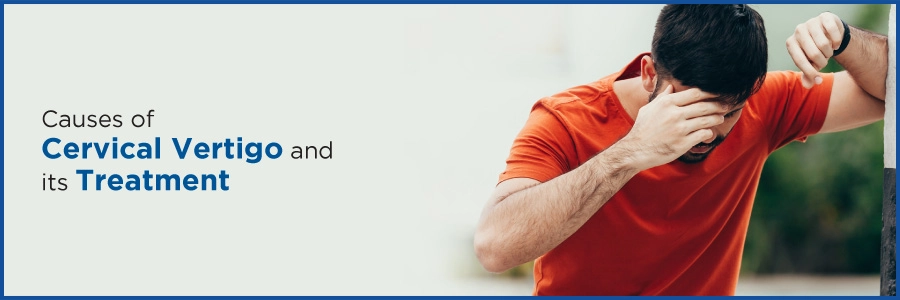
What is Cervical Vertigo?
Cervical vertigo, also known as cervicogenic dizziness, is characterized by dizziness, nausea, and general instability. However, many additional symptoms may occur, as well as there are many potential causes of the condition. Poor neck posture, neck disorders, or cervical spine trauma causes this condition. A head injury that disrupts head and neck alignment frequently causes this, such as whiplash. Neck pain that is accompanied by dizziness can worsen over time, resulting in a loss of concentration and difficulty standing or walking straight. A variety of underlying medical conditions could cause this condition.
Symptoms
Cervical vertigo symptoms may appear months or years after a cervical spine injury. Anxiety and stress can both impact the severity of your symptoms. This is because stress and anxiety affect muscle tone and sympathetic nervous system responses.
Cervical vertigo symptoms can differ from person to person. Some of the most common are:
- headache
- nausea
- vomiting
- ear pain or ringing
- neck pain
- loss of balance while walking, sitting or standing
- weakness
- problems concentrating
This condition can cause dizziness that lasts for minutes or hours. When the pain in the neck goes away, the dizziness may go away as well. Exercise, rapid movement, and sometimes sneezing can worsen symptoms.
Causes
A variety of factors can cause cervical vertigo, many of which are related to traumatic neck injuries or chronic, long-term injuries. A few of the causes are listed below:
Atherosclerosis
Blockages in the arteries of the neck may lead to injury in the area that could cause vertigo. This could be due to atherosclerosis, which is the thickening of the artery walls.
Neck Injuries
Neck pain is frequently associated with people suffering from cervical vertigo. Cervical vertigo can be caused by a variety of factors, most of which are caused by a traumatic injury to the neck. Whiplash from a car accident, for example, can cause damage to the head and neck, resulting in cervical vertigo.
Osteoarthritis
The most common type of arthritis affecting millions of people worldwide is osteoarthritis. It happens when the protective cartilage that cushions the ends of your bones worsens. The hands, knees, hips, and spine joints are the most commonly affected by the disorder. Advanced osteoarthritis in the spine can cause the vertebrae in the neck to wear down, extra pressuring the nerves, arteries, and the spinal cord itself. This could send erroneous signals to the brain or obstruct blood flow, resulting in vertigo.
Secure your health with a second opinion. Make informed decisions and book your appointment today!
Get A Second OpinionA slipped disk
Slipped discs are more common in the lower back, but they can occur anywhere along the spine.
When the softer center of a spinal disc pushes out through a crack in the spine, it is called a slipped disc or herniated disc. Sometimes there are no symptoms. Sometimes, however, it may push into a nerve or artery, causing symptoms such as cervical vertigo.
Poor posture
Cervical vertigo may also be caused by poor posture. The cervical spine may compress over time because of poor sitting posture or issues like "text neck," in which a person frequently bends their neck to look at electronic devices or books.
This can put additional strain on the arteries in the neck, causing some people to experience neck pain and vertigo.Cervical vertigo is more common in people who have had severe head trauma, cervical arthritis, or herniated cervical discs. Whiplash injuries in car accidents frequently result in cervicogenic dizziness.
Treatment
The treatment of cervical vertigo depends on addressing the underlying cause. If you have neck pain or a degenerative neck disease, stick to your medical treatment plan to reduce vertigo symptoms.
Treatment also includes symptom management, which involves using one or more medications to ease symptoms while doctors work to treat the underlying condition. This may include taking dizziness medications and pain relievers and muscle relaxants.
Most doctors will also suggest therapies like physical therapy and posture training to help create space in the neck, increase range of motion, and build muscle strength. Physical therapies help in the musculoskeletal system and cervical movements that can cause dizziness and pain. Manual therapy treatments and vestibular exercises can frequently help in resolving cervical vertigo.
Cervical vertigo is a type of vertigo that can be treated with the right medication and preventative measures. The symptoms of this condition can vary and can be diagnosed by an expert doctor. As a result, if you have any symptoms, see a doctor. Finally, this is a treatable condition that may require immediate attention.
Citations
How to diagnose cervicogenic dizziness - PMCCervicogenic Dizziness - Vestibular Disorders Association
A new type of cervical vertigo: Head motion–induced spells in acute neck pain | Neurology
Musculoskeletal diseases as a causal factor of cervical vertigo
